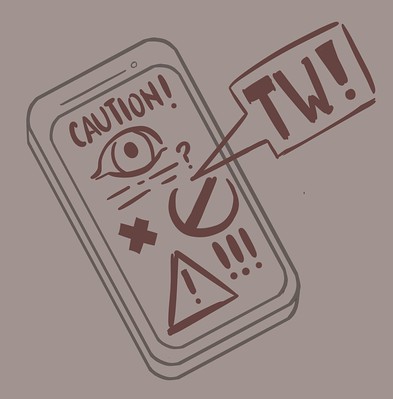Trigger warnings can be more harmful than helpful

Trigger warnings reveal society’s growing consciousness towards mental health issues, but may be the wrong approach towards better mental health treatment
October 2, 2022
Trigger warnings have started to show up more and more often on almost every piece of consumable content, from articles to TikTok videos and tweets, and even to classroom policies. The debate around trigger warnings is, in fact, said to have stemmed from a school policy at Oberlin College in 2013 that advised faculty to provide trigger warnings and making such material optional, as triggers could disrupt a student’s learning and put them in an unsafe environment. The policy was quickly dropped after faculty complained about how much material could potentially be considered triggering. But there may be stronger reasons behind ending a trigger warning policy.
Trigger warnings are meant to warn people about content that could be potentially disturbing for the consumer. These can be seen in front of images, text, or any other content. They are more specifically used as a precaution for people with post-traumatic stress disorder (PTSD) or any kind of trauma someone may have. In the case of the content resulting in illicit traumatic reactions or events, trigger warnings generally allow people to decide whether to continue with or move away from content.
Kate Manne, a professor of philosophy at Cornell University, explains in her New York Times op-ed that trigger warnings are not meant to help a consumer avoid content, but instead, “allow those who are sensitive to these subjects to prepare themselves for reading about them, and better manage their reactions.”
But in reality, according to psychology and research, trigger warnings simply do not have much of an effect on consumers, and in some cases can be much more harmful towards the reader. According to a meta-analysis on the effect of trigger warnings, an important type of research that takes together all other previous major studies on the topic to derive further conclusions, the presence of trigger warnings does not impact the consumer’s choice to consume that piece of content, and in some specific trials during the study, it actually caught more attention from people with PTSD, which contradicts the entire purpose of trigger warnings.
In fact, if you think about it logically, trigger warnings contains enough keywords that might trigger someone which explains why the studies in the meta-analysis showed that trigger warnings may make people’s PTSD symptoms worse. If you were rejected by 13 out of the 15 colleges you applied to, you would be pretty upset. Now imagine someone came to you the day before decisions came out (all in one day in this imaginary scenario) and told you that 13 out of the 15 colleges you applied to would reject you as a “heads up”. You would still be pretty upset, just at an earlier time, if not more upset.
The concept of protecting the mind of the reader behind trigger warnings is can be connected to the term “safetyism”, a word first used in the book The Coddling of the American Mind by Jonathan Haida and Greg Lukianoff. “Safetyism” refers to the moral culture of making choices that put safety above all else, and Haida and Lukianoff talk about its rise in the 2010s with parents and their children, such as parents restricting their children from watching certain movies or shows. But such a moral structure comes with an important trade off between the safety of children and their development in emotional management and stability.
In the same way, trigger warnings in theory may protect the safety of the consumer’s mind, but will fail to help them not only face or overcome their anxieties but may also actually, from a long-term perspective, enhance the severity of their anxieties, which betrays the original purpose of trigger warnings that Manne describes. Exposure may strain readers, but it also allows them the opportunity to learn how to better deal with experiences that can trigger PTSD symptoms.
If anything, businesses and companies are the ones who benefit the most out of using trigger warnings. In today’s world, it’s often the reader’s responsibility to discern whether or not a news source is credible or not. In the same way, trigger warnings make it the consumer’s responsibility to decide whether or not to consume a piece of content. Although allowing consumers to specifically dictate their content with trigger warnings gives consumers great power, whether good or bad, this not only pushes the responsibility of a company’s content possibly causing traumatic symptoms in the reader, but it also ends up benefitting the platforms and companies behind trigger warnings far more than consumers.
According to a survey done by the National Coalition Against Censorship (NCAC), only around 17% of people believe that trigger warnings have a positive effect. Given how small this percentage is, it begs the question of why trigger warnings have such widespread usage. The answer lies in the mentality of “better safe than sorry.” If readers choose to read a story based on whether or not a story has a trigger warning or not, then companies will always choose to add a quick trigger warning because it might mean attracting more viewers resulting in more profit.
The entire debate around trigger warnings ties into the bigger issue of mental health that the younger generations have recently been generating greater and more informed awareness of due to the rising rates of suicide, depression, and other mental health conditions and efforts to understand it. Although the corresponding rise in the use of trigger warnings show the progress society has made towards treating mental health issues and treating people with mental health issues, trigger warnings ultimately fail to address the problems they mean to address.




